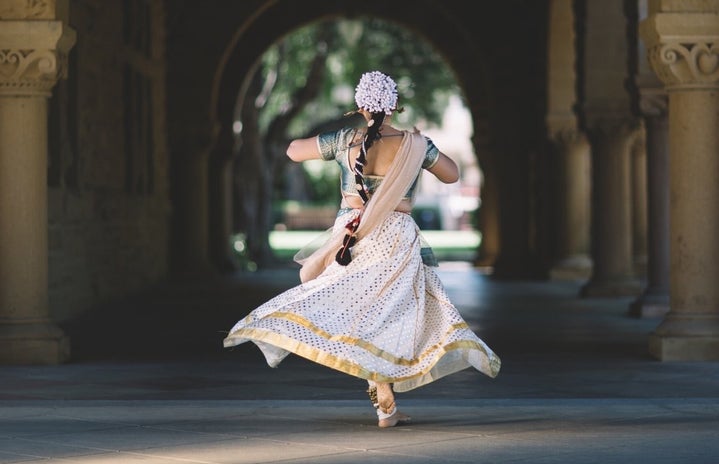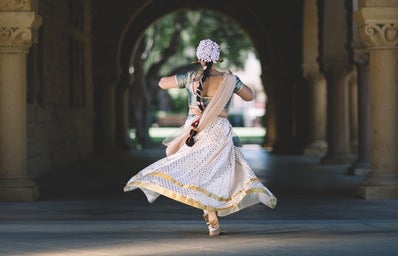Classy, elegant, sexy, flashy, formal, casual – sarees can be anything you want them to be. The saree is so classically Indian, that it’s hard to imagine that the saree as we know it today is a relatively modern creation.
The word saree itself comes from the Sanskrit word sattika, found first in the early Jaina and Buddhist scriptures. The earliest saree was a three-piece set – a strip of cloth serving as a chest band, the predecessor of a blouse, a long piece of cloth tied in a dhoti style between the legs, and a shawl to drape over the chest.
The saree as we know it today, metamorphosed over the years, even influenced by Mughal and British ideals. The loose cloth was experimented with – its drapes, patterns, colors, fabrics and blouses – giving rise to numerous styles as well as variants of the outfit itself. For instance, when the dhoti style bottom turned into a long flowy skirt, it gave birth to a modern-day favorite – the lehenga choli. As for the styles, sarees aren’t the same everywhere. Here are some of the most classic drapes of the saree across the subcontinent.
-
Nivi: The quintessentially Indian saree, this drape originated in Andhra Pradesh, and made its way into the rest of the country. The outfit requires a skirt into which one end of the 6-meter saree is tucked and then wrapped around the wearer. The saree is pleated in the front, and the pallu or the remaining strip is thrown over the left shoulder, either pleated or loosely draped. Being one of the easiest to wear, it is no surprise that this saree drape can be seen everywhere – graduations, weddings, schools, offices, anywhere!
-
Danda Mundu: The traditional Kerala saree, the Danda Mundu, unlike most other sarees, makes use of two strips of cloth. The 4-foot strip of cloth used to cover the bottom half is usually white, in true Kerala fashion. It’s wrapped around the waist once in an anticlockwise direction, and the remaining length is pleated and tucked off-center, to the left. Another shorter strip of cloth (2.5 meters) is tucked at the left waist, brought around the torso, and draped over the left shoulder. The mundu, or the lower garment, is also worn by men and is believed to have been inspired by the Graeco-Roman costume, Palmyrene.
-
Seedha Palla: The Seedha Palla or Seedha Pallu, is the Gujarati variant of the Andhra Nivi saree. The saree is wrapped in the same way, and pleated at the center. However, the pallu is not left freely over the left shoulder. Rather, it is completely brought over to the right shoulder and dropped up to mid-thigh and pinned in place. The long pallu is pleated neatly and allowed to fan over the torso. The loose left end is tucked at the left waist. The royal drape, also called the Maharani drape, was styled by the elite royals of Northern India, including those of Uttar Pradesh, Rajasthan and Haryana.
-
Athpourey: This Athpourey drape is a Bengali-style saree. One starts by tucking the saree at the right waist and taking it around from right to left. Then, two huge box pleats are made, once from left to right and once from right to left. This gives the pallu ample length. The pallu is pleated and placed over the left shoulder. It is then taken across the back. The upper loose end of the pallu is brought under the right arm to the front and fastened at the right shoulder. Traditionally, keys are hung from the pallu and symbolize the woman’s authority over the house.
-
Nauvari: The Maharashtrian Nauvari saree is a nine-meter-long saree. The saree is first tied over the naval. The loose box of cloth is pleated in the front center, and these pleats are taken in between the legs and tucked into the back, near the tailbone. This essentially gives the saree a more dhoti or pant style look as opposed to the usual open skirt style. The pallu is secured on the right side and is comparatively shorter. The saree was styled to mimic the traditional male lower garments to ensure ease of movement.
-
Pinkosu: The Pinkosu saree is a Tamizh style saree, and literally means “pleats at the back”. One end of the saree is first pleated and placed at the back. The other end isn’t tucked into anything – rather, it is secured in place by wrapping the rest of the saree from left to right around the waist. The pallu is then pleated and secured at the left shoulder, before being brought across the back and to the front, to be tucked in place at the left hip. The saree was once popular across South India, but is today worn most commonly by the Tamizh women who work in the fields.
Considering that these saree styles are barely a handful of the nearly 80 drapes that are found across the subcontinent, sarees are undoubtedly an Indian staple! So the next time you plan on wearing a saree, why not try a different style? Don’t forget to arm yourself with several dozens of safety pins (which you’ll undoubtedly lose in the folds of your saree), a video tutorial (which will convince you that tying the saree is much easier than it actually is), enough time (because who really gets it right the first time?), and of course, a saree, blouse and its accessories before you begin experimenting!


